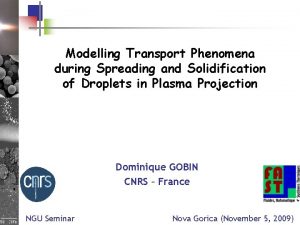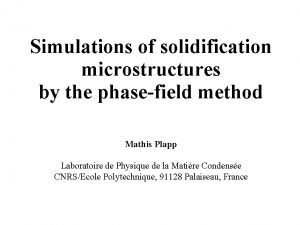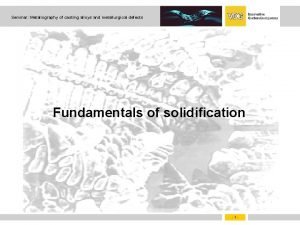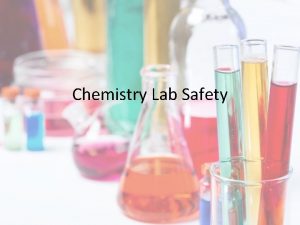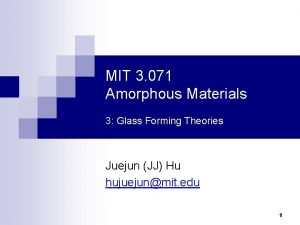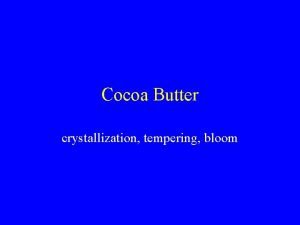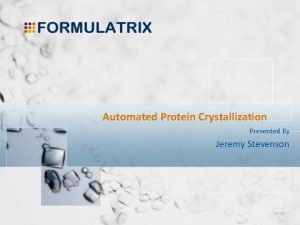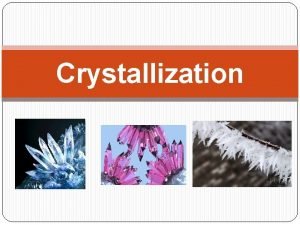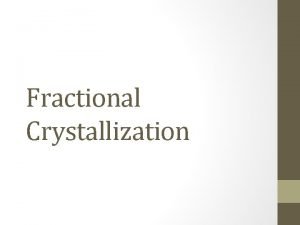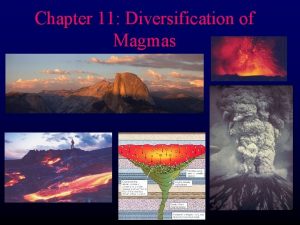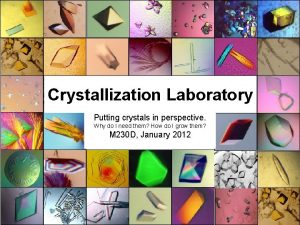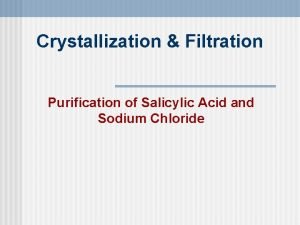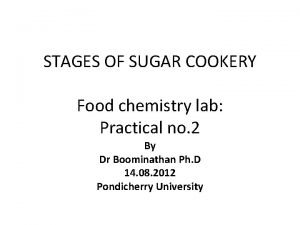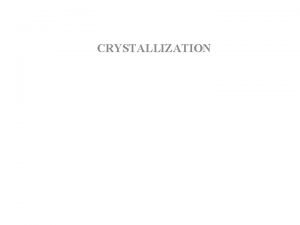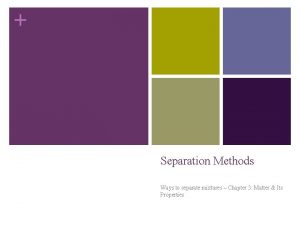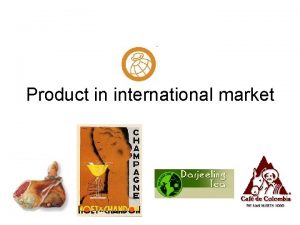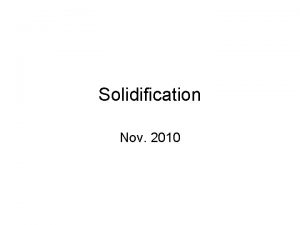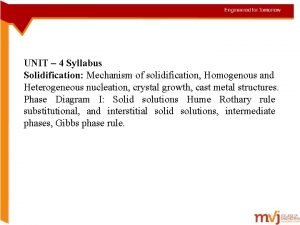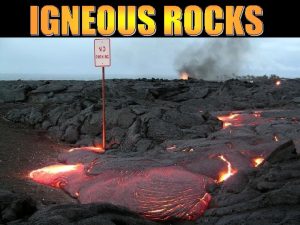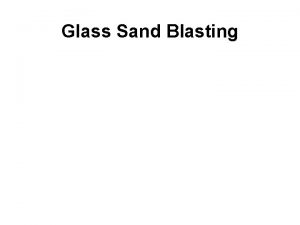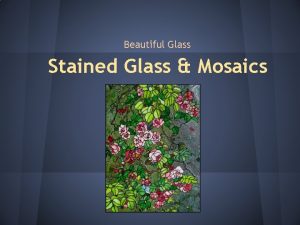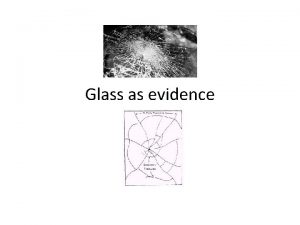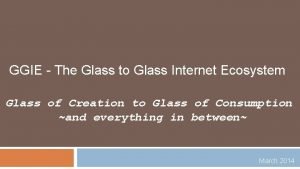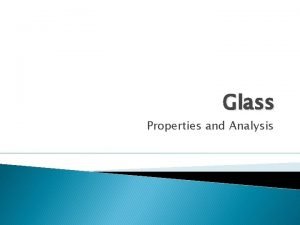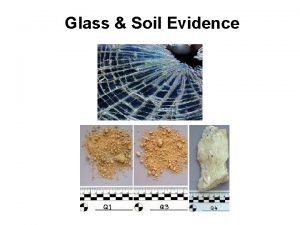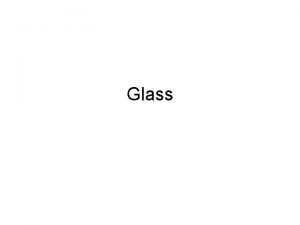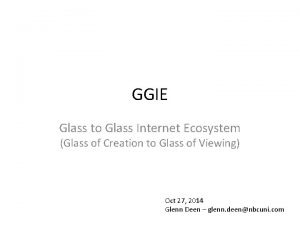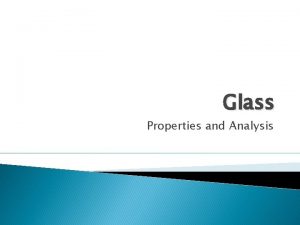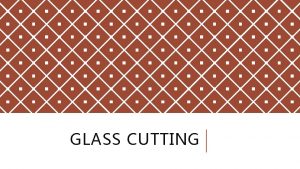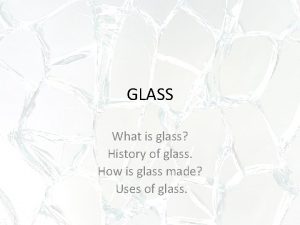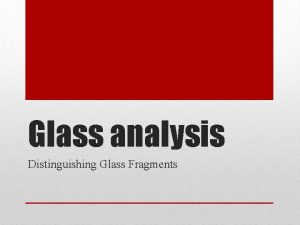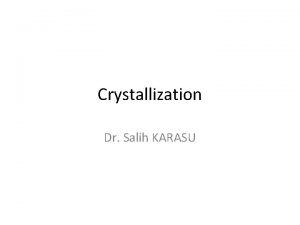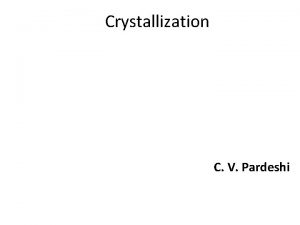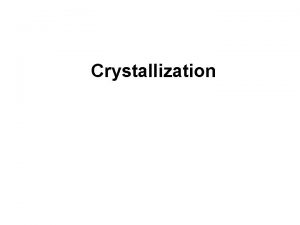Solidification Crystallization Glass Transition q Crystallization versus Formation
























- Slides: 24

Solidification, Crystallization & Glass Transition q Crystallization versus Formation of Glass q Parameters related to the formation of glass Effect of cooling rate Glass transition temperature q Structure of Glasses Radial distribution function Part of MATERIALS SCIENCE & A Learner’s Guide ENGINEERING AN INTRODUCTORY E-BOOK Anandh Subramaniam & Kantesh Balani Materials Science and Engineering (MSE) Indian Institute of Technology, Kanpur- 208016 Email: anandh@iitk. ac. in, URL: home. iitk. ac. in/~anandh http: //home. iitk. ac. in/~anandh/E-book. htm

Glasses and Amorphous Materials q The word ‘glass’ and ‘amorphous material’ can be interchangeably used in most circumstances though there is a small technical difference (which we will consider later). q Based on atomic structure it is one of the 3 fundamental states of matter. In glasses the atoms do not have long range order (LRO), though they may have short range order (SRO). q The SRO could be very different from that encountered in crystals (even the crystals formed out of the same composition). E. g. one may find local icosahedral clusters. q In a simplistic picture, glass can be thought of as a time snapshot of the liquid. q Typically glasses have a higher ‘free-volume’ as compared to the crystal (the preferred crystal structure that the material is expected to form for a given T & P). q Concepts like Lattice and motif thus cannot be used in glasses. This automatically implies that many of the properties of a glasses will be drastically different as compared to the corresponding crystal (thought he composition may be identical and the density not very different). For example, dislocations (in the usual sense) cannot be defined in glasses and hence the plastic deformation of glasses have to take place by other mechanisms (e. g. shear banding). One kind of glass is the window pane glass, but glasses come in many forms (based on bonding, etc. ). Many of these glasses are not transparent. Matter AMORPHOUS STATE / VISCOSITY GAS SOLID STRUCTURE QUASICRYSTALS LIQUID CRYSTALS

q It is assumed that glasses are metastable and there exists at least one crystal structure which has a lower Gibbs free energy (at constant, T, P). This implies if sufficient activation energy is provided (usually by heating), then glasses will tend to crystallize. At low temperatures the glass in frozen in a disordered state and may remain so for a long time (e. g. glass used in the window panes are not expected to crystallize in geological time scales). q On heating glasses (see page on “heating of glass” more on this) they tend to crystallize. This process occurs by nucleation and growth of crystallites in the amorphous matrix. Many materials like long chain (and branched) polymers are difficult to crystallize completely (more on this soon). As we shall see soon, in some circumstances a partially crystallized microstructure can give us better properties. q Many different kinds of materials can be obtained in the amorphous state. These include: polymers, inorganic materials, metals and alloys, semiconductors, etc. In fact if we look around us, most of the materials we see (like wood, building walls, etc. ) are not fully crystalline. q From the above it is clear that the term ‘amorphous’ (which is based on atomic level structure) is used for a wide class of materials and based on the specifics of the material involved, the properties will be varied. As expected, polymeric glasses will have poor tolerance to heat, while inorganic glasses may withstand high temperatures.

Formation of Glass q Certain materials are easy glass formers (e. g. silicates, long chain polymers, etc. ), which others are difficult to amorphize (e. g. pure metals, simple alloys, etc. ). q Glasses can be synthesized in many ways. Three typical ways are listed below. q 1) From the vapour state By condensing the vapour of the material onto a cold substrate. q 2) From the liquid state Quenching from the melt (usually fast cooling from the molten state). The rate of quenching required depends on the material (and parameters to be discussed soon). To amorphize certain alloys cooling rates of the order of 106 K/s needs to be employed, while certain special alloys and silicate materials can be slowly cooled to get glass (even ~1 K/s). q 3) In the solid state By severely deforming the crystals (say a polycrystal) amorphous state can be obtained. Ball milling has been one of the popular examples for this method (for alloys).

Glass Forming Ability & Resistance to Crystallization q Glass Formation Ability (GFA) should be differentiated with Resistance to Crystallization (RTC) also called Glass Stability (GS). GFA is in the cooling direction (i. e. “how slowly can I cool to still get a glass? ”), while RTC is in the heating direction (i. e. “to how high a temperature can I heat and still retain a glass? ”). Many parameters have been developed to characterize materials with respect to GFA and RTC. q Crystallization is favoured by high enthalpy of fusion ( Hfusion) and a low viscocity ( ). The critical Gibbs free energy for the nucleation of a crystal is related to the enthalpy of fusion as in the equation below. Large Hfusion implies a lower G*crystallization, which further implies ease of crystallization. An embryo becomes a nucleus by jump of atom across the interface from liquid to crystal. This requires a activation enthalpy ( Hd). The activation enthalpy is related to the log of viscosity. This implies that a lower viscosity allows for easier atomic jumps, which in turn favours crystallization. Click here to revise concepts on nucleation

q Metals (in molten state) with a high enthalpy of fusion (~10 k. J/mole) and low viscosity (110 poise) are difficult to amorphize. Pure metals (like Al, Cu) are virtually impossible to amorphize by quenching from the liquid state. Some alloys (one popular brand name is Metglas ) can be cooled at a high cooling rate (using processes like melt-spinning or splat quenching) of 106 K/s to obtain a foil of amorphous material. [one popular commercial composition of metallic glass is Metglas is Fe 85 wt. %, Si 10 wt. %, B 5 wt. %]. q Needless to say one dimension of the sample will have to be thin for fast heat extraction (which implies that we end up with foils). q Inorganic glasses on the other hand, with low Hfusion and high viscosity are easily amorphized. In fact some oxides may have to be added promote crystallization. [E. g. Borosilicate glass: 81% Si. O 2, 13% B 2 O 3, 4% Na 2 O/K 2 O, 2% Al 2 O 3; softening point of 820 C]. ↑ Hfusion Thermodynamic Crystallization favoured by Kinetic ↓ Hd Log [Viscosity ( )] High → (10 -15) k. J / mole Low Metals Silicates Low → (1 -10) Poise High → (~1000) Poise Enthalpy of activation for diffusion across the interface Very fast cooling rates ~106 K/s are used for the amorphization of alloys Difficult to amorphize metals Easily amorphized

q In contrast to metals silicates, borates and phosphates tend to form glasses q Due to high cation-cation repulsion these materials have open structures q In silicates the difference in total bond energy between periodic and aperiodic array is small (bond energy is primarily determined by the first neighbours of the central cation within the unit)

Measures of Glass Forming Ability (GFA) q There are many parameters used to characterize the glass forming ability of a material. Most important of these are: Critical Cooling Rate (qcr) and Critical Diameter (dcr). q These two parameters are related to one another

Heating of Glass q As pointed out before, a glass will tend to crystallize on heating. q If crystallization does not intervene, then glasses will slowly soften (i. e. the viscosity will decrease) and will begin to flow. This is what enables glow blowing operations, wherein silicate glass is heated and blown to form bottles. This is what we observe when we heat wax candles. q This implies that glasses do not have a well defined melting point like crystals. q The crystallization of glass can be studied by using Differential Scanning Calorimetry (DSC). In DSC a sample is heated at a constant rate (say 20 C/min) and hence the origin of the word ‘scanning’. The heat absorbed or evolved (with respect to a reference pan and hence called ‘differential’) is measured as a function of temperature. Typical plot in the next page. q In a DSC plot (where +Y axis is exothermic): (i) glass transition appears as a step, (more about glass transition later) (ii) crystallization(s) as exothermic peak(s) and (iii) melting as a endothermic valley. More than one crystallization peaks may be observed if more than one type of crystal forms during the heating.

q Materials which show glass transition (as indicated in the DSC plot) are called glasses and those which do not are referred to as Amorphous materials. In amorphous materials it is assumed that crystallization masks the glass transition (the presumed reason as to why we do not observe glass transition). q The temperature interval between Tg and Tx [= (Tx Tg)] is called the supercooled liquid region. The properties of the material below Tg will be different (often drastically) from that above. Supercooled liquid region Glass Tx Tg Glass Tg Amorphous solid Tg Glass Heat glass Crystal Glass Cool liquid Crystal Tx Heat Amorphous solid Cool liquid Crystal Tx Often metallic glasses crystallize first (in a ‘viewpoint’ before Tg) Hence the glass transition temperature in heating is masked by crystallization (hence not observed experimentally)

§ DSC is a versatile tool to study phase transformations. § By using various scanning rates (temperature scanned per unit time, K/s or C/min) in conjunction with the Kissinger analysis the activation energy for the phase transformations can be determined. § The crystallization temperature (Tx) and glass transition temperature (Tg) are determined from the DSC plot as shown in the figure. § The crystallization process is exothermic (as the system is going from a higher internal energy amorphous structure to a lower energy crystal), while the melting process is endothermic (energy has to be supplied to break the bonds in a crystal and to cause melting). The glass transition is ‘step-like’ in the DSC plot. Differential Scanning Calorimetry (DSC) Glass transition ‘step’ Note crystallization peak (exothermic) Material gives out heat during crystallization Note melting valley (endothermic) Material absorbs heat to melt (the latent heat) Sample heated at constant rate

Glass Transition q We have seen as to how glass transition is indicated in a DSC plot. But, typically glass transition is understood first in the cooling direction. q When a liquid is cooled slowly and its volume is plotted as a function of the temperature, there is a ‘sudden shrinkage’ at the melting point when crystallization takes place. q On the other hand if crystallization is avoided and the material is freezes into a glass. Volume → Instead of V we can plot other extensive thermodynamic quantities (i. e. they all show same behvaiour) → S, H, E Li Slow change in volume Sudden shrinkage in volume during crystallization Glass T → d i qu “All materials would amorphize on cooling unless crystallization intervenes” Crystal Tg Tm Glass transition temperature

Volume → Change in slope T → Tf Fictive temperature (temperature at which glass is metastable if quenched instantaneously to this temperature) → can be taken as Tg

Effect of rate of cooling Volume → As more time for atoms to arrange in closer packed configuration Slower cooling Lower volume T → Slower cooling Higher density Lower Tg

q On crystallization the viscosity abruptly changes from ~100 → ~1020 Pa s q A solid can be defined a material with a viscosity > 1012 Poise If the glass crystallizes on heating (at Tx), before Tm then T = Tx Tg is a measure of the glass formability. Log (viscosity) → Crystal The region between Tg and Tx is the supercooled liquid region in this case. Glass Supercooled liquid T → Tg Tm Liquid

Glass transition temperature of various types of glasses q Note that there are elemental, alloy and compound glasses. Boding varies from covalent to Van der Waals type. Glass transition temperature ranges from low values (65 K) to high values (1430 K). Material Bonding Tg (K) Si. O 2 Covalent 1430 Pd 0. 4 Ni 0. 4 P 0. 2 Metallic 580 Be. F 2 Ionic 570 Polystyrene mixed 370 Se 310 H 2 O Hydrogen 140 As 2 S 3 Covalent 470 Isopentane Van der Waals 65 R. Zallen, Physics of Amorphous Solids, John Wiley and Sons, 1983.

Glass-ceramic (pyroceram) q A composite material of glass and ceramic (crystals) can have better thermal and mechanical properties (especially spalling resistance). q But glass itself is easier to form (shape into desired geometry). Heterogenous nucleating agents (e. g. Ti. O 2) added (dissolved) to molten glass Shaping of material in glassy state Ti. O 2 is precipitated as fine particles Held at temperature of maximum nucleation rate (I) Heated to temperature of maximum growth rate

Growth Tmaximum U T → Tmaximum I q q q Nucleation Glass t → Partially crystallized Glass Even at the end of the heat treatment the material is not fully crystalline Fine crystals are embedded in a glassy matrix Crystal size ~ 0. 1 m (typical grain size in a metal ~ 10 m) Ultrafine grain size good mechanical properties and thermal shock resistance Cookware made of pyroceram can be heated directly on flame.

Radial Distribution Function q In crystals interatomic distances are well defined. In a CCP crystal the distances are: a 2/2, a, a 6/2, a 2, etc. These vectors are shown in the figure below. q In glasses this is not so. The minimum approach distance is (r 1 + r 2), however the distances after that are not discrete. Hence we have to come up with measures as to how the distribution of atoms varies from a given reference atom. One such measure is the Radial Distribution Funtion. q For a distribution of atoms* the Radial Distribution Function (g(r), RDF*), describes how density varies as a function of distance from a reference atom. This reference atom could be any atom, as there are no preferred sites in a glass and ‘things’ average out due to the randomness of atomic positions. q RDF is a measure of the probability of finding an atom at a distance of ‘r’ in a spherical shell, relative to that for an ideal gas (i. e. the probability is normalized w. r. t. to an ideal gas). q Fourier transform of the RDF is related to the structure factor. * Can also be defined for molecules, etc. ** RDF is closely related to the Pair Correlation Function

RDF continued… q RDF (g(r)) is defined as in the formula below. § → number density- number of atoms/volume § n → number of atoms in the volume between r & (r + dr) Note that the discrete peaks found in the case of crystals has become diffuse


Solidification and Crystallization

Metals Thermodynamic ↑ Hfusion High → (10 -15) k. J / mole Crystallization favoured by Kinetic ↓ Hd Log [Viscosity ( )] Low → (1 -10) Poise Enthalpy of activation for diffusion across the interface Difficult to amorphize metals Very fast cooling rates ~106 K/s are used for the amorphization of usual alloys → splat cooling, melt-spinning.

Silicates Thermodynamic ↑ Hfusion low Crystallization favoured by Kinetic ↓ Hd Log [Viscosity ( )] High → (1000) Poise Enthalpy of activation for diffusion across the interface Easily amorphized Certain oxides can be added to silica to promote crystallization
 Solidification
Solidification Solidification
Solidification Casting
Casting Glass ceiling vs glass escalator
Glass ceiling vs glass escalator Hot glass looks the same as cold glass
Hot glass looks the same as cold glass Does hot glass look like cold glass
Does hot glass look like cold glass Glass transition
Glass transition Emblem of england
Emblem of england Zachariasen rules for glass formation
Zachariasen rules for glass formation Formation initiale vs formation continue
Formation initiale vs formation continue Triangulation vs crystallization
Triangulation vs crystallization Tempering cocoa butter crystallization
Tempering cocoa butter crystallization Jeremy stevenson formulatrix
Jeremy stevenson formulatrix Equipment used in crystallization
Equipment used in crystallization In bio
In bio Define fractional crystallization
Define fractional crystallization Liquid immiscibility in magmatic differentiation
Liquid immiscibility in magmatic differentiation Degree of research question crystallization
Degree of research question crystallization Protein crystallization
Protein crystallization Crystallization
Crystallization Different stages of sugar
Different stages of sugar Fractional crystallization
Fractional crystallization Krystal crystallizer
Krystal crystallizer Decanting
Decanting Product adaptation examples
Product adaptation examples
